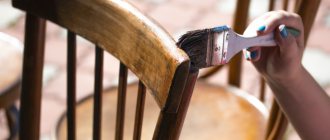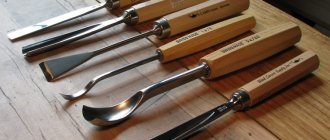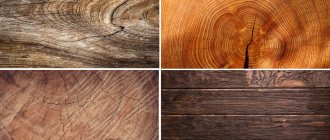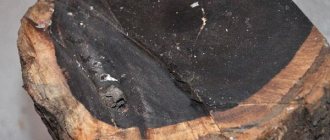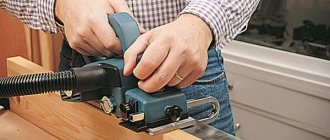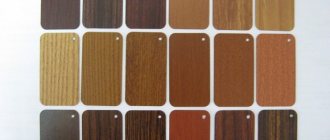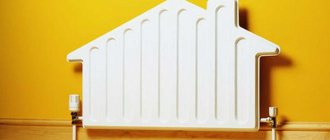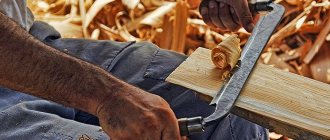Tools for hand planing.
Purpose of the planing operation.
After sawing, the workpieces have risks, roughness, and warping. All these defects are eliminated by planing. In addition, when planing, the workpieces are given the desired shape.
Tools for hand planing.
For manual planing, wooden planes are used. Planer (Fig. 22, a
) consists of a wooden body into which a knife is inserted, firmly secured with a wedge. The wedge rests on shoulders made from the sides of the tap hole. The plane of the tap hole surface to which the knife is attached should ensure a tight fit. Swinging of the knife is not allowed. In the sole of the plane, i.e. in the lower part of the body, there is a narrow slot (span) 5.7 ± 0.5 mm wide, through which the knife blade protrudes beyond the sole.
For better work with the plane and convenient movement of it through the material, there is a horn in the front part. The sole of the plane or jointer should be even and smooth. Due to the fact that the sole is subject to abrasion, it is glued from hornbeam, maple, white acacia, ash or beech wood. The horn, stop, wedge, and pads are made from wood intended for the manufacture of the sole of the body, and from birch, elm or birch bark wood. The handles are made from uncoated plywood board PF‑A. Glue the sole of the plane into an overlay with waterproof adhesives. Wood for making a plane or jointer should not have cracks, rot, sprouts, wormholes, unfused knots, resin pockets, etc., its humidity should be 10 ± 2%.
The surfaces of the parts of planes and jointers, with the exception of the sole of the bodies (pads) and the surface of the wedge adjacent to the knife, are coated with light waterproof varnish.
Sherhebel (Fig. 22, b
) is designed for rough planing of wood along, across and at an angle to the grain. After planing with Sherhebel, the surface of the wood is uneven - with traces of grooves in the form of grooves. This is because the knife blade has an oval shape with a radius of 35 mm. During operation, the knife is released up to 3 mm; The shavings are narrow and thick. The weight of the Scherhebel is 0.82 kg.
Planer with a single knife (Fig. 22, c
) are used to level the surface after sawing or planing after treatment with Sherhebel. The blade of a knife with a width of 40–50 mm is straight, it extends 1 mm. Since this plane does not have a chipbreaker (hump), the chips are formed without breaking, so the surface of the processed wood often gets burrs and sometimes chips. Planer weight 0.9 kg.
Planer with double knife (Fig. 22, d
) are used for fine planing of wood, cutting off the ends, as well as curled wood and wood with burrs. This plane, in addition to the knife, has a counter-knife-chipbreaker. The presence of a chipbreaker improves the quality of planing, since the chips, after separation, rise up the knife, bend and, falling on the chipbreaker, break. The breaking of the chips after separation prevents the possibility of flakes or chipping of the wood surface. The closer the chipbreaker is installed to the knife, the sooner it will break off the chips, therefore, for better processing of wood, the chipbreaker is placed closer to the knife. But at the same time, it should be taken into account that the chipbreaker cannot be placed very close (less than 2 mm), since the chips will get clogged under the blade and planing will be difficult. Planer weight 0.97 g.
Rice. 22. Planes: a – general view; b – sherhebel; c – with a single knife; g – with a double knife; 1 – body; 2 – horn; 3 – entrance; 4 – wedge; 5 – knife; 6 – emphasis; 7 – plug; 8 – sole; 9 – sherhebel knife; 10 – single plane knife; 11 – double plane knife; 12 – chipbreaker; 13 – knife with chipbreaker.
In addition to wooden planes, metal sherhebels and planes with a single and double knife are used for planing wood (Fig. 23).
The plane is a metal body into which a knife is inserted, secured in the body with a screw. The horn and handle are made of wood. The amount of chips removed is controlled by the extension of the knife. To do this, you need to release the screw and move the knife up or down the desired amount, and then fasten the screw again.
Metal planes are 1.5–1.7 times heavier than wooden ones. They are used primarily for planing hardwood and for repair work.
The jointer (Fig. 24) is used for final finishing planing, as well as for jointing individual parts. The jointer is almost 3 times longer than the plane, which allows you to plan long parts with it. In the front part of the jointer on the body there is a plug, with a hammer blow on which the knife is knocked out of the body from the tap hole. The knife blade should protrude 1 mm. When wood with a wavy surface is processed with a jointer, chips are obtained in the form of small pieces, and when repeated, continuous thin chips are formed, indicating that planing should be completed, since the surface is smooth. Planer weight 3.25 kg. Shorter parts are processed with a semi-jointer having a shorter body (530 instead of 650 mm). To clean wood that is scuffed and curled, use a plane with a shortened body - a sander. The sander has a narrow slot (5 mm wide) and an increased additive angle (60°), due to which, when working, it removes thin chips and the surface of the wood is processed cleaner. The knife blade extends by 0.5 mm.
Rice. 23. Metal planes: a – sherhebel; b – plane with a single knife; c – plane with double knife; 1 – body; 2 – horn-handle; 3 – screw; 4 – knife; 5 – handle; 6 – rod; 7 – clamp; 8 – base for the knife
Rice. 24. Jointer: a – general view; b – jointer knife; 1 – plug; 2 – handle.
Tsinubel (Fig. 25) serves to form small, barely noticeable grooves and hairiness on the surface of the wood for gluing (veneering). The knife has a serrated blade. When replacing a serrated knife in a tzinubela with a regular one, it is used as a grinder.
The end plane (Fig. 26) is used as a regular plane and as a plane for planing the ends, since the knife installed in it at an angle to the side surface facilitates the planing process and improves the quality of processing. When planing at an angle to the axis of the board, a regular plane can be used as an end plane.
Rice. 25. Tsinubel: a – general view; b – knife
Zenzubel (Fig. 27) is used for manual selection and stripping of quarters in carpentry parts. The body of the zenzubel is high (80 mm) and narrow with a straight sole. The presence of a side hole in the body ensures free exit of chips during the planing process and improves the quality of processing. The zenzubel knife is sharpened on the side and bottom, thanks to which it forms a quarter when working. Zenzubel weight 0.38, kg.
Rice. 26. End plane: a – general view; b – plane sole
Rice. 27. Zenzubel: a – general view; b – wedge; c – side view of the housing; d – bottom view; d – knife.
Rebate (Fig. 28) is used for selecting quarters in carpentry parts; unlike the zenzubel, it has a stepped sole. Its weight is 0.5 kg
Rice. 28. Falzgebel: a – general view; b – knife
Purpose of the planing operation.
After sawing, the workpieces have risks, roughness, and warping. All these defects are eliminated by planing. In addition, when planing, the workpieces are given the desired shape.
Tools for hand planing.
For manual planing, wooden planes are used. Planer (Fig. 22, a
) consists of a wooden body into which a knife is inserted, firmly secured with a wedge. The wedge rests on shoulders made from the sides of the tap hole. The plane of the tap hole surface to which the knife is attached should ensure a tight fit. Swinging of the knife is not allowed. In the sole of the plane, i.e. in the lower part of the body, there is a narrow slot (span) 5.7 ± 0.5 mm wide, through which the knife blade protrudes beyond the sole.
For better work with the plane and convenient movement of it through the material, there is a horn in the front part. The sole of the plane or jointer should be even and smooth. Due to the fact that the sole is subject to abrasion, it is glued from hornbeam, maple, white acacia, ash or beech wood. The horn, stop, wedge, and pads are made from wood intended for the manufacture of the sole of the body, and from birch, elm or birch bark wood. The handles are made from uncoated plywood board PF‑A. Glue the sole of the plane into an overlay with waterproof adhesives. Wood for making a plane or jointer should not have cracks, rot, sprouts, wormholes, unfused knots, resin pockets, etc., its humidity should be 10 ± 2%.
The surfaces of the parts of planes and jointers, with the exception of the sole of the bodies (pads) and the surface of the wedge adjacent to the knife, are coated with light waterproof varnish.
Sherhebel (Fig. 22, b
) is designed for rough planing of wood along, across and at an angle to the grain. After planing with Sherhebel, the surface of the wood is uneven - with traces of grooves in the form of grooves. This is because the knife blade has an oval shape with a radius of 35 mm. During operation, the knife is released up to 3 mm; The shavings are narrow and thick. The weight of the Scherhebel is 0.82 kg.
Planer with a single knife (Fig. 22, c
) are used to level the surface after sawing or planing after treatment with Sherhebel. The blade of a knife with a width of 40–50 mm is straight, it extends 1 mm. Since this plane does not have a chipbreaker (hump), the chips are formed without breaking, so the surface of the processed wood often gets burrs and sometimes chips. Planer weight 0.9 kg.
Planer with double knife (Fig. 22, d
) are used for fine planing of wood, cutting off the ends, as well as curled wood and wood with burrs. This plane, in addition to the knife, has a counter-knife-chipbreaker. The presence of a chipbreaker improves the quality of planing, since the chips, after separation, rise up the knife, bend and, falling on the chipbreaker, break. The breaking of the chips after separation prevents the possibility of flakes or chipping of the wood surface. The closer the chipbreaker is installed to the knife, the sooner it will break off the chips, therefore, for better processing of wood, the chipbreaker is placed closer to the knife. But at the same time, it should be taken into account that the chipbreaker cannot be placed very close (less than 2 mm), since the chips will get clogged under the blade and planing will be difficult. Planer weight 0.97 g.
Rice. 22. Planes: a – general view; b – sherhebel; c – with a single knife; g – with a double knife; 1 – body; 2 – horn; 3 – entrance; 4 – wedge; 5 – knife; 6 – emphasis; 7 – plug; 8 – sole; 9 – sherhebel knife; 10 – single plane knife; 11 – double plane knife; 12 – chipbreaker; 13 – knife with chipbreaker.
In addition to wooden planes, metal sherhebels and planes with a single and double knife are used for planing wood (Fig. 23).
The plane is a metal body into which a knife is inserted, secured in the body with a screw. The horn and handle are made of wood. The amount of chips removed is controlled by the extension of the knife. To do this, you need to release the screw and move the knife up or down the desired amount, and then fasten the screw again.
Metal planes are 1.5–1.7 times heavier than wooden ones. They are used primarily for planing hardwood and for repair work.
The jointer (Fig. 24) is used for final finishing planing, as well as for jointing individual parts. The jointer is almost 3 times longer than the plane, which allows you to plan long parts with it. In the front part of the jointer on the body there is a plug, with a hammer blow on which the knife is knocked out of the body from the tap hole. The knife blade should protrude 1 mm. When wood with a wavy surface is processed with a jointer, chips are obtained in the form of small pieces, and when repeated, continuous thin chips are formed, indicating that planing should be completed, since the surface is smooth. Planer weight 3.25 kg. Shorter parts are processed with a semi-jointer having a shorter body (530 instead of 650 mm). To clean wood that is scuffed and curled, use a plane with a shortened body - a sander. The sander has a narrow slot (5 mm wide) and an increased additive angle (60°), due to which, when working, it removes thin chips and the surface of the wood is processed cleaner. The knife blade extends by 0.5 mm.
Rice. 23. Metal planes: a – sherhebel; b – plane with a single knife; c – plane with double knife; 1 – body; 2 – horn-handle; 3 – screw; 4 – knife; 5 – handle; 6 – rod; 7 – clamp; 8 – base for the knife
Rice. 24. Jointer: a – general view; b – jointer knife; 1 – plug; 2 – handle.
Tsinubel (Fig. 25) serves to form small, barely noticeable grooves and hairiness on the surface of the wood for gluing (veneering). The knife has a serrated blade. When replacing a serrated knife in a tzinubela with a regular one, it is used as a grinder.
The end plane (Fig. 26) is used as a regular plane and as a plane for planing the ends, since the knife installed in it at an angle to the side surface facilitates the planing process and improves the quality of processing. When planing at an angle to the axis of the board, a regular plane can be used as an end plane.
Rice. 25. Tsinubel: a – general view; b – knife
Zenzubel (Fig. 27) is used for manual selection and stripping of quarters in carpentry parts. The body of the zenzubel is high (80 mm) and narrow with a straight sole. The presence of a side hole in the body ensures free exit of chips during the planing process and improves the quality of processing. The zenzubel knife is sharpened on the side and bottom, thanks to which it forms a quarter when working. Zenzubel weight 0.38, kg.
Rice. 26. End plane: a – general view; b – plane sole
Rice. 27. Zenzubel: a – general view; b – wedge; c – side view of the housing; d – bottom view; d – knife.
Rebate (Fig. 28) is used for selecting quarters in carpentry parts; unlike the zenzubel, it has a stepped sole. Its weight is 0.5 kg
Rice. 28. Falzgebel: a – general view; b – knife
Preparing the plane for work
To determine the dullness of a plane knife, you need to take the plane with your left hand with four fingers by the sole, and with your thumb on top of the block, turn the plane with the sole up so that the light falls on the chamfer and blade of the knife; by turning the plane down or up, conditionally around the cutting edge (blade), find such a position when a white stripe of the cutting edge (bluntness radius) appears against the background of the darkened chamfer. When you turn the knife in one direction, the chamfer darkens, in the other it becomes lighter, and the knife blade is distinguished by a blunt line in the form of a rounded needle.
Trimming workpieces: a, b - from both sides to the middle, c - with an auxiliary block, d - position of the worker’s feet when trimming
Jaggedness, bending and indentations of the blade can be detected by inspection or by touch with the thumb of your right hand, running along the blade along the chamfer. It is advisable to wet your finger with water before doing this.
Sharpening a plane knife
To form (sharpen) a chamfer, you need to take the knife by the end with your right hand so that it rests in the palm of your hand, place your thumb and forefinger on the edges, three fingers on the lower (back) edge of the knife, press the knife against the grinding wheel or block with your left hand, set the knife at the required angle to the tangent of the circle and perpendicular to it. In this case, the chamfer should be in contact along the entire length and width. Grind off the metal layer until the nicks, chips, skew or oval chamfer disappear and a burr appears on the upper edge of the knife. Burrs are detected by touch when moving the thumb along the front edge of the knife or the chamfer of the blade. Burrs can be seen when holding the top face up to the light in the direction of the cutting edge. In this case, the light rays should be directed along the knife to the cutting edge, and the knife should be rotated around the cutting edge.
When sharpening, it is necessary to hold the knife at a constant angle and, with slight pressure, press the chamfer against the sharpener with its entire surface, moving it across the grinding wheel.
Periodically moisten the bevel with water so that metal particles are washed away and the hardening of the cutting edge of the knife is not released.
After sharpening a knife on a coarse-grained sharpener, traces of large grains and burrs remain on the blade. Therefore, the knife is finally sharpened on a fine-grained whetstone.
Jointer
It’s worth considering the design of this machine from the fact that it can be single-sided or double-sided. If a double-sided machine is used, then two adjacent surfaces of one workpiece can be processed at once. There are also machines with manual feed or with mechanized feed. If with manual feeding everything is simple and clear, then for mechanical feeding it is necessary that an automatic feeder be installed nearby. In some cases, an integrated conveyor feed mechanism may be used instead. Also, these machines are equipped with devices such as chip collectors, which are used for chips and dust. It is connected to the factory exhaust network.
Modern wood processing
Today there are two ways to carry out this operation. It can be done manually, or it can be done mechanically. If we talk about the mechanical style of processing, the most widespread operation is carried out on a jointing machine.
Since today technologies have been developed quite strongly, machines began to be equipped with program control, robotic systems, and automatic lines. All these improvements have led to the fact that the processing on machines has become of higher quality, and it has also been possible to significantly increase accuracy.
Machine processing technology
When operating a jointer that has a manual feed, one worker is required. The worker takes the workpiece from the stack and assesses its condition. Lumber that is too warped should be discarded. If it is not very concave or warped, then it can be used; the product is placed on the table with the concave side. Next, the workpiece is pressed against the ruler with the left hand, and fed to the machine with the right hand. In this case, the end of the wood will push back the fan fence. This will open access to the shaft with rotating knives. When the front part is processed, it is necessary, still holding the workpiece with your left hand, to gradually push it forward with your right, at a uniform speed. In this case, of course, you need to keep your hands at a safe distance from the knives.
If a jointer with a mechanical feed is used, the lumber feed speed is calculated based on the maximum power of the electric motor. After processing, the product must be checked. Deviation from the plane is allowed no more than 0.15 mm for every 1000 mm. Deviation of adjacent surfaces is allowed no more than 0.1 mm at a height of 100 mm.
When using this tool for planing wood, it is very important to ensure that there are no defects or irregularities on the surface. If during operation the knife encounters such a defect, the workpiece may twitch, and the worker’s hand lying on the product may fall into the knife gap.
The most dangerous is planing wood that is quite thin, narrow or short. For this reason, if the machine has a manual feed, then there are restrictions on the dimensions of the workpieces. Length up to 400 mm, width up to 50 mm, thickness up to 30 mm.

